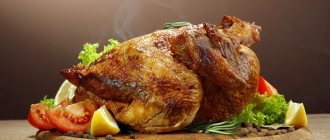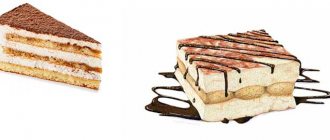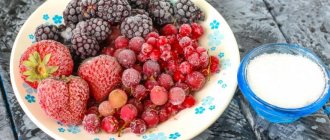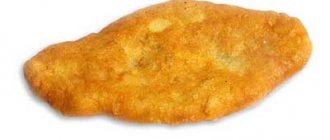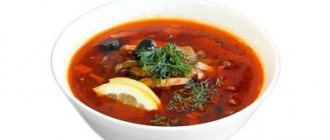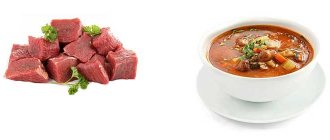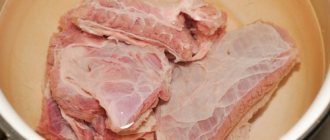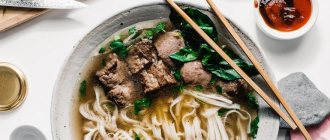Related Products
Chili soup (57 cal) Carrot coriander soup (100 cal) Lentil soup (54 cal) Vegetable soup (41 cal) Clear soup (8 cal) Chicken soup (60 cal) Potato soup (63 cal) ) Mushroom soup (51 kcal.) Tomato soup (43 kcal.) Bean soup (74 kcal.) Fish soup (ear) (16 kcal.) Turtle soup (53 kcal.) Onion soup (44 kcal.) Noodle soup ( 35 cal) Beef soup (50 cal) Pea soup (67 cal) Vegetable pasta soup (44 cal) Broccoli soup (60 cal) Homemade soups (22 cal) Turkey soup (38 cal) .) Cream soups (52 cal) Meat soup (50 cal) Oyster stew soup (40 cal) Chinese soup (33 cal) Shark fin soup (46 cal)
The calorie content of cream cheese soup is 171 kcal.
Ingredients: Water, Beetroot, Potatoes, White cabbage, Onions, Carrots, Tomato paste, Sugar, Salt, Sour cream, Herbs
Ingredients: Cream 10%, Potatoes, Salmon, Tomatoes, Leeks, Carrots, Herbs, Vegetable oil, Salt, Ground black pepper
Ingredients: Water, Potatoes, Chicken breast, Tomatoes, Buckwheat, Carrots, White onions, Vegetable oil
Ingredients: Potatoes, Beef, Onions, Pickles, Meat broth, Tomato paste, Garlic
Ingredients: Potatoes, Ground beef, Carrots, Fresh mushrooms, Canned green peas, Onions, Canned corn, Sour cream, Milk, Butter, Chopped parsley, Tomato sauce, Vegetable oil, Salt, Ground black pepper
Ingredients: Oat flakes, Potatoes, Onions, Champignons, Garlic, Salt, Ground black pepper
Composition of nutrients, BJU
Cheese soup
| For quantity: 100 grams | ||
| Calories — 76 | Calories from fat - 40 | |
| BJU | ||
| Total fat content | 4.46g | |
| Saturated | 1.91g | |
| Polyunsaturated | 0.42g | |
| Monounsaturated | 1.48g | |
| Cholesterol | 9mg | |
| Total carbohydrate content | 6.6g | |
| Dietary fiber | 0.78g | |
| Sugar | 1.38g | |
| Squirrels | 2.41g | |
| Vitamins and microelements | ||
| A - 94 µg | C - 0.92 mg | |
| B-6 – 0.03 mg | B-12 - 0.06mcg | |
| D - 0mcg | E - 0.06 mg | |
| Calcium 36mkg | Iron 0.28 mg | |
| Magnesium 5mg | Zinc 0.23mg | |
| Potassium 90 mg | Sodium 363 mg | |
Distribution of calories for BJU:Carbohydrates (36%) Fats (52%) Proteins (12%) | ||
Micro- and macroelements in Cheese soup
Cheese soup contains the following elements: Mono- and disaccharides, Cholesterol, Ash, Starch, Water, Organic acids, Dietary fiber, Unsaturated fatty acids, Sodium, Potassium, Phosphorus, Magnesium, Calcium, Sulfur, Copper, Boron, Silicon, Aluminum, Titanium , Strontium, Iodine, Manganese, Chromium, Fluorine, Molybdenum, Vanadium, Cobalt, Nickel, Selenium, Tin, Zinc, Iron, Chlorine.
| Micro and macro element | Meaning |
| Mono- and disaccharides, g. | 1,2 |
| Cholesterol, mg | 22,8 |
| Zola, Mr. | 0,3 |
| Starch, Mr. | 1,9 |
| Water, city | 75,5 |
| Organic acids, g. | 10,1 |
| Dietary fiber, g. | 0,3 |
| Unsaturated fatty acids, g | 0,1 |
| Sodium, mg | 141,1 |
| Potassium, mg | 71,3 |
| Phosphorus, mg | 113,7 |
| Magnesium, mg | 9,4 |
| Calcium, mg | 131,2 |
| Sulfur, mg | 16,9 |
| Copper, µg | 18,3 |
| Boron, µg | 1,2 |
| Silicon, mg | 0,1 |
| Aluminum, µg | 46,8 |
| Titanium, µg | 0,4 |
| Strontium, mcg | 3,9 |
| Iodine, mcg | 3 |
| Manganese, mg | 0,0224 |
| Chromium, µg | 0,7 |
| Fluorine, mcg | 7,7 |
| Molybdenum, mcg | 2,1 |
| Vanadium, mcg | 3 |
| Cobalt, µg | 0,7 |
| Nickel, µg | 0,07 |
| Selenium, mcg | 0,7 |
| Tin, µg | 3,2 |
| Zinc, mg | 0,5619 |
| Iron, mg | 0,3 |
| Chlorine, mg | 187,9 |
Soup with cheese according to the minus 60 system
Even though this is a fairly “young” dish, its popularity is comparable to other, more familiar, recipes in the European culinary tradition. Cheese soup is easy to prepare, it is quite light and very tasty. In addition, there are several variations of its recipe, each of which can contain different products:
- all types of cheese, with the exception of curd;
- any vegetables, herbs and spices;
- shrimp, chicken, sausage or frankfurters;
- eggs, rice, crackers;
- milk, cream, wine, sour cream, butter.
Thus, nothing interferes with the flight of fancy: coming up with your own cooking option is not at all difficult. Moreover, you don’t need that much cheese per liter of water - only 80 - 120 grams.
However, cheese soup (including dietary) has a number of disadvantages:
- There is no point in preparing it in advance, since the smell and taste quickly lose their intensity;
- this dish is classified as perishable;
- Many recipes are high in calories, so you will have to “lighten” them yourself if you are taking care of your figure.
To prepare you will need to take:
- Chicken breast fillet - 450 grams.
- Onions - 1 medium size piece.
- Cheese – 150 grams.
- Carrots - 3 root vegetables.
- Water – one and a half liters.
Cut the breast fillet into several large pieces, place in boiling water and cook until tender. Remove the boiled meat from the broth.
Chop the onion, carrots and cheese (processed cheese cannot be taken) into three on a grater. Place onions and carrots in boiling broth and cook for a quarter of an hour. Add grated cheese into the soup in small portions to dissolve better. Cook for another 5 minutes. Serve the finished soup with a piece of boiled chicken breast and chopped herbs.
Well, is everything you need at hand?
Now turn up the music for culinary inspiration, sing along boldly and let's get started!
I suggest you listen to Céline Dion - The Power Of Love...
So, let's get to cooking :)
1. First, grind the products. Let's turn the meat into small pieces. The onion, despite its tear-producing nature, will be cut into smaller pieces. And chop the champignons into nice slices.
2. Fry the chicken fillet in butter until it is covered with a golden crust. This process does not take long, so don’t stray far from the stove :)
3. It’s better to heat the vegetable oil side by side in another frying pan. Send the chopped onion into it, and when it turns transparent golden, introduce it to its companions - wonderful champignons!
Stir this mixture periodically until the juice that the mushrooms give evaporates.
4. In the meantime, it’s time to place the browned meat in boiling salted water. And after about 20-30 minutes, this water can rightfully be called chicken broth.
5. Then add the main thing to the broth - cheese! For this important step, the cheese needs to be prepared. But nothing complicated - we’ll just grate it.
By the way, it would be nice to first put the processed cheese in the freezer for a few minutes - then it will be easier to grate.
Pour the cheese into the pan and stir until it is completely dissolved.
6. Following the cheese, fried onion and mushroom goes into the soup, followed by chopped garlic. Nutmeg, ground black pepper and herbs will also not be superfluous in our delicate aromatic soup.
The end result is a hearty, tasty dish. It will not only bring pleasure, but will also not prevent you from enjoying the reflection in the mirror :)
After all, its calorie content is very low and it fits perfectly into the weight loss menu.
What is processed cheese made from?
The main component for the production of processed cheese is hard varieties of the product of the same name. Heads that are unripe or incorrectly formed during the manufacturing process are processed.
The idea of processing hard cheeses, which for some reason cannot be sold, came to the minds of cheese-making experts and connoisseurs of this product - the Swiss.
Walter Gerber and Fritz Stettler melted a batch of Emmental cheese that was unpresentable for sale. Sodium citrate was added to the base to give it a special taste. This event took place in 1911. The new product was liked by many, and within a few years the processed cheese appeared on sale.
Much time has passed since then, and other components began to be used in the manufacturing process. There is processed cheese made from cottage cheese, milk powder, cream concentrate, butter with the addition of all kinds of seasonings and flavorings.
Kinds
The production technology is the same, but this does not mean that the products are of the same type.
Processed cheese has different percentages of fat content. It ranges from 25–60%. The product differs in consistency: cheeses are dense, viscous, and pasty. They can be sterilized or pasteurized, have different shapes and packaging, and differ in taste.
The main types include:
- Lomtevoy is quite dense and elastic. It is available with fat content up to 70%. It cuts and grates well, so it’s great for making salads and soups. Has a range of flavors. Usually the usual rectangular shape, packed in foil.
- Spready cheeses are similar in consistency to thick sour cream. A high percentage of moisture and fat makes them plastic. They are great spread on bread, crackers, and crispbreads. This product is available in plastic jars or boxes. It has a variety of tastes and aromas.
- Sausage processed cheese has the densest consistency of all types. It is shaped like sausage sticks – hence the name. It contains a small percentage of fat, so it is considered the lowest calorie among all processed cheeses. A distinctive feature of the product is additional processing - smoking. Cumin and hot pepper add piquancy to the creamy taste.
- Sweet processed cheese can be paste-like or chunky. Cocoa, vanilla, chocolate chips, and coffee are used as additional ingredients.
In addition to milk processed cheeses, products based on vegetable fats are also produced. Most often it is soy. They are suitable for people with lactose intolerance.
How to melt cheese without a microwave: TOP ways
So it will melt even on other products and grated on a coarse grater, or even not grated at all during longer heat treatment, even in a frying pan or in a saucepan with the lid closed, even in the oven, even in the microwave, and even in a steam bath. Other answers. Processed cheeses are fermented milk products that have undergone additional heat treatment. This concept also includes a separate type of cheese products - products obtained by mixing natural processed cheeses with various ingredients.
This variety is distinguished by its low cost and special homogeneous structure. Different types of cheese products are used for heating, depending on the recipe. There are classic combinations of varieties in certain dishes:. The correct temperature is the key to successfully melting cheese. The degree of heat treatment depends on the type of product:. Exceeding the specified temperature limits will lead to separation of cheese products.
The product should be heated gradually and added to the dish at the end of cooking. The degree of rendering of animal protein directly depends on its fat content, but the structure of the product plays an important role.
Melted cheese is featured in many classic recipes. Its delicate, bright, rich taste makes dishes interesting and original. If previously housewives used it mainly to add to pasta and hot sandwiches, now pizzas, cheese rolls, sauces and even Swiss fondue are on the tables. In this article you will learn how to melt cheese correctly. In order not to rack your brains over how to melt cheese, first you need to choose it correctly.
Low-fat ingredients should not be used for heating. When such varieties are exposed to high temperatures, the products become hard and stick to the dishes. The microwave is a universal device for preparing melted cheese.
The device, thanks to its adjustable power, allows you to bake the product or bring it to a paste-like state.
Ingredients:
If you don't have a microwave, you can use a regular oven. There are several ways to melt the cheese mass:.
Please note that when using the last two methods, it is important to control the baking time. The cheese will melt within a couple of minutes; keeping the product in the oven for a long time will turn the ingredient into a caked hard mass.
If the ingredient is melted for sauce or as a dish on its own, it is recommended to add cream or milk to the container. These ingredients will reduce the risk of burning of the main product. Melted cheese in a frying pan is suitable if you don’t have an oven. This method allows you to prepare cheese sauce.
The product is finely grated and left at room temperature. Grease a heated frying pan with butter. Next, fry a couple of tablespoons of wheat flour and add half a glass of full-fat milk. This mixture is brought to a boil.
Description of preparation:
Then you should reduce the gas to a minimum and add the grated main ingredient into the sauce. Another famous dish cooked in a frying pan is cheese sticks.
Any hard variety is suitable for cooking.
Cheese strips are rolled in egg and breading, and then fried in a heated frying pan until golden brown. The appetizer has a crispy crust and a soft, stretchy filling.
Please note that it is impossible to melt cheese in its pure form in a frying pan. It is more difficult to control the temperature of the iron surface on a burner than in an oven or microwave. As a result, the product will be fried on the outside and remain hard on the inside. Swiss fondue is one of the most famous cheese dishes. The recipe is classified as an appetizer or dessert. To prepare you will need:.
